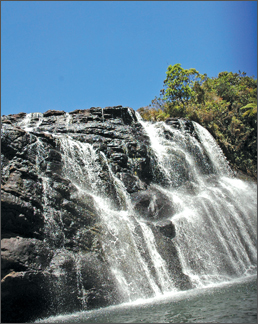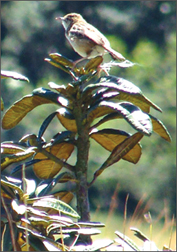
Horton Plains
Where the world ends:
Suraj A. Bandara
The Horton Plains are located on Sri Lanka's highest plateau as a
gift to central province, between altitudes of 2,000 and 2, 300m. The
landscape typically consists of undulating lands covered in a tropical
cloud of forests or verdant montane savannah grasslands, locally known
as patannahs. Visiting Horton Plains is a quite popular amongst locals,
who mostly come to admire the views from the park's thrilling
escarpments such as World's End at weekends. (For this reason I
recommend that you try to organize your visit during a weekday as this
ensures that you will experience the Plain's isolated serenity).
|

A magnificent view of Horton Plains. Pictures by Chinthana
Wasala and Saliya Rupasinghe |
Horton Plains is a popular tourist destination, with World's End
being the key attraction. Both local and foreign visitors come there to
witness the World's End. In the six months ending August 2009, the
Hortain Plains National Park has earned a revenue of Rs.20.1 million. It
is increasing considerably due to rapid growth of tourist arrivals.
"Almost all tourists who come to Sri Lanka, come here to see the World's
End" said an officer in the entrance gate with a encouraging smile.
The best time to visit the park is early in the morning as this is
when the air is likely to be clearest so that you can enjoy the best of
the views. In the afternoons, clouds tend to descend and the area
becomes clouded in mist. This is equally enthralling though and provides
evidence for the evolution of this forest type. Allowing a half-day
should give you plenty of time to enjoy it all at a leisurely pace. We
reached there by 10.30 am which is very convenient to see all the
beauties. But we lost a big chance to catch the scenes of animals since
it was too early. A regular visitor who had come 20th times, told us "If
you want to witness animals' movement you must come in the evening."
Visitors to the park can follow a 10km loop that incorporates all of the
spectacular features, enabling them to enjoy them while adhering to the
strict rules for environment protection and nature conservation.
|

The footpath to the World’s end on grassy plains |
According to the field officer who works in the park the Plains were
actually named after Sir Robert Wilmot Horton, a hunter and explorer who
was singularly responsible for the slaying of all of the elephants in
the area between 1831 and 1837. Although there is little hope of
elephants ever returning, you can at least walk around in comparative
safety admiring the many other interesting creatures around and about.
Of these perhaps the most worthy of a mention are the Samber Deer, a
common sight at dusk and in the early hours of the morning.
|

One of the special attraction of Horton Plains: Baker’s
Falls |
Baker's Falls is another special attraction. It is one of the most
eye-catching places to visit at Horton Plains. Baker's Falls is situated
about three kilometres from the Information Centre which is at the
entrance to the National Park.
The footpath to the Baker's Falls lies through the misty, cold, and
grassy plains across the narrow brooks. Walking barefoot along this path
is a real delight, when the feet touch the moist grass and cool water.
The 20 metre-wide waterfall plunges over a wide rock into a gorge
covered with beautiful wild flowers. It's so spectacular that you don't
feel like leaving it. Many, not only our group members but also those
who had come there told us that by sitting on a rock with their feet in
the icy cold water, they could wash away their weariness. The
breathtaking beauty of the scenic view combined with the soothing sound
of the waterfall, refreshed the mind. It is something that will remain
in memory. It is accepted that Sir Samuel Baker discovered this
waterfall. He was a hunter and an adventurous farmer who resided in the
island from 1847 to 1855. He had come across the falls while exploring
the hunting grounds. It has been named after him.
|

The beauty of nature |
The vegetation of the park is classified into two distinctive groups.
Wet patana (montane grasslands) has been spread around 2,000 hectares
and 1,160 hectares are occupied by the subtropical montane evergreen
forests. Nearly 750 species of plants belonging to 20 families have been
recorded from the park. The vertebrate fauna of the region includes 24
species of mammals, 87 species of birds, 9 species of reptiles and 8
species of amphibians. It is recorded that Sri Lankan elephants had been
disappeared from the region in the 1940s. A labourer at the park said
they have counted that a large herd of about 1,500 Sri Lankan Samber
Deer are roaming in the park. Most of them come into seen in the
evening, he said.
Horton Plains is home for many endemic birds. This is identified as
one of the Important Bird Areas (IBAs) in Sri Lanka.
"This is a key wildlife area, all six highland endemic birds are
found here," explained a bird watcher who had come on an inspection tour
to the park.
An officer who seemed to really love the park was disappointed about
the threats the Plains have. There are some tourism related issues such
as plant removal; littering, fires and noise pollution are the major
conservation issues. In addition, gem mining, timber logging, the
collection of plants for ornamental and medicinal purposes;
encroachment, poaching, and vehicle traffic are the other threats. The
spread of invasive alien species such as Gorse, brackens and Pennisetum
threaten the native flora. The introduced rainbow trout may have
affected endemic species of fish, amphibians and crustaceans, the
officer explained us with frustration. According to him the most
dangerous and the most recent threat was first reported in 1978.
As predicted, it was a really new experience and made all of us
eco-friendly with the serenity of the beauty of the park. Though we made
an exhaustive effort to see the park, the memories would refresh all the
experience we collected after the tour. We must be grateful that our
motherland has inherited such an unblemished and beautiful child to
nourish and look after.
[ Horton Plains National Park]
* A protected area in the central highlands of Sri Lanka
* Has an altitude of 2,100 - 2,300 metres (6,900-7,500 ft)
* Was designated a national park in 1988 |



